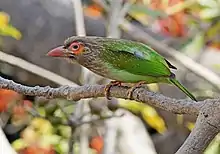Brown-headed barbet
The Brown-headed barbet (Psilopogon zeylanicus) is an Asian barbet species native to the Indian subcontinent, where it inhabits tropical and subtropical moist broadleaf forests. It is widespread from the Terai in both Nepal and India to Sri Lanka, and listed as Least Concern on the IUCN Red List.[1] It is an arboreal species of gardens and wooded country which eats fruit and insects. It is fairly tolerant of humans and often seen in city parks. It nests in a tree hole, laying 2-4 eggs. It forages on mangos, ripe jackfruit, papaya, banana, figs and similar cultivated fruit trees. Its habitat includes urban and country gardens though it tends to eschew heavy forest. It nests in a suitable hole in a tree that it will often excavate. Both sexes incubate the eggs and often communicate with each other using their Kura, kura calls.[2]
| Brown-headed barbet | |
|---|---|
 | |
| Calls recorded in Bharatpur, India | |
| Scientific classification | |
| Kingdom: | Animalia |
| Phylum: | Chordata |
| Class: | Aves |
| Order: | Piciformes |
| Family: | Megalaimidae |
| Genus: | Psilopogon |
| Species: | P. zeylanicus |
| Binomial name | |
| Psilopogon zeylanicus (Gmelin, 1788) | |
| Synonyms | |
|
Megalaima zeylanica[2] | |
The adult has a streaked brown head, neck and breast, and a yellow eye patch. The rest of the plumage is green. It is 27 cm (11 in) long with a large head, short neck and short tail.
Its call is a repetitive kutroo…kutroo…kutroo, but silent in the winter. Others take up the call when one starts.
Local names
In Sinhala language, the brown-headed barbet is known as polos kottoruwa - පොලොස් කොට්ටෝරුවා.
References
- BirdLife International (2016). "Psilopogon zeylanicus". IUCN Red List of Threatened Species. 2016: e.T22681597A92912739.
- Ali, Sálim; Daniel, J. C. (2002). The Book of Indian Birds (Thirteenth ed.). New Delhi: Bombay Natural History Society and Oxford University Press. p. 194. ISBN 9780195665239.
External links
| Wikimedia Commons has media related to Psilopogon zeylanicus. |
- BirdLife International (2019). "Brown-headed Barbet Psilopogon zeylanicus".
